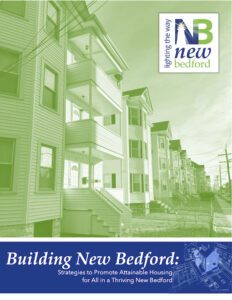Who is a member?
Our members are the local governments of Massachusetts and their elected and appointed leadership.

New Bedford released its new housing plan on March 29.
Armed with a new plan and federal funding, the city of New Bedford is tackling housing challenges from multiple angles, envisioning policies aimed at stimulating new development, repurposing vacant properties, promoting home ownership, and preventing homelessness.
On March 29, the city released “Building New Bedford,” a 32-page report detailing what the city has done, is doing, and plans to do to address its local housing shortage and affordability gap for residents, with a particular focus on increasing housing supply and lowering housing costs for residents by reducing costly development delays. The city also recently received millions in federal funding to help address another of the plan’s central goals: reducing housing stability and homelessness.
Mayor Jon Mitchell and other city officials are also calling on neighboring communities to participate in the housing discussion, saying the city doesn’t have the capacity to solve housing problems single-handedly for an entire region.
“As the urban center of its region, New Bedford is leading the way in helping to increase the supply of housing at every income level, and we are committed to working in concert with our suburbs to ensure that the burden is fairly shared across the region,” Mitchell said. “The plan we just released spells out in detail how we in Greater New Bedford can make housing more attainable for everyone.”
The plan, which took shape over the past several months, contains 22 measures divided into six categories: facilitating new housing production across income levels, making use of existing housing and space, promoting home ownership and independent living, updating the city’s regulatory framework, establishing a regional housing approach, and addressing housing instability and homelessness.
Housing and Community Development Director Joshua Amaral said the plan calls for greater collaboration among city departments and with public boards and committees to lessen barriers to development. Among other efforts, the city will pursue zoning changes to facilitate development and will aim to approve large projects within 90 days.
“We want to communicate to the development community that New Bedford is open for business,” Amaral said.
Officials want to streamline the process for developers, but they are not willing to sacrifice quality of life for residents, or New Bedford’s historic character, with its cobblestone streets and centuries-old buildings, Amaral said. Projects will still need to fit in with the surroundings, he said, and be responsive to the residents’ concerns.
“It’s a balance,” Amaral said. “No two projects are the same, but I guess it’s to say that we want to show that you can fast-track development, you can streamline things for developers and remove barriers to development, but also not totally open the floodgates to an unplanned community.”
Besides trying to encourage new housing projects, the city will look to revive empty residential properties, get housing developed onto vacant lots, and sell unused city property and buildings that can be converted into housing.
New Bedford recently received more than $3.1 million from the federal HOME-American Rescue Plan Program to bolster housing stability and reduce homelessness. The city’s use of the HOME-ARP money will include $900,000 to develop affordable rental housing, $700,000 for shelter beds, $500,000 for rental assistance programs, and nearly $600,000 for nonprofits providing supportive services and community housing development initiatives.
In early April, the city announced that the U.S. Department of Housing and Urban Development awarded more than $2 million through its Continuum of Care program, which will go primarily toward supportive housing units to transition people out of shelters, Amaral said.